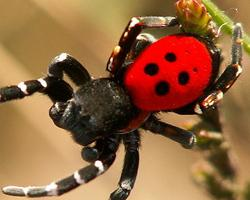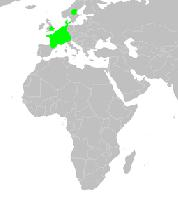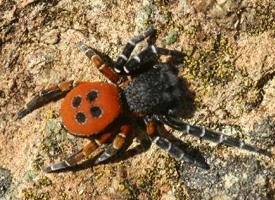
Váhy a míry
| Délka | od 6 do 16 mm |
|---|
Stav ohrožení
| Ohrožen |
Popis zvířete
The Ladybird spider, scientifically known as Eresus sandaliatus, is a fascinating and visually striking species of spider belonging to the Eresidae family. This species, primarily found across Europe, has garnered attention due to its distinctive appearance and unique life history, making it a subject of interest among naturalists and conservationists alike.Eresus sandaliatus is relatively small, with males typically measuring between 6 to 9 millimeters in length, while females are larger, ranging from 10 to 16 millimeters. Despite their modest size, what truly sets these spiders apart is their remarkable coloration. The males, in particular, boast a vividly colored abdomen featuring a bright red base adorned with four large, black spots, reminiscent of the pattern found on a ladybird beetle, hence the name "Ladybird spider." This striking contrast not only makes the male easily identifiable but also serves as a warning to predators about their venomous nature. The females, on the other hand, are more subdued in appearance, with a dark, velvety brown to black coloration that helps them blend into their surroundings.
Ladybird spiders inhabit well-drained, sandy soils where they construct silk-lined burrows. These burrows serve as a refuge as well as a strategic hunting ground, as the spiders often create a silk "tripwire" network around the entrance to detect and capture prey. Their diet primarily consists of small insects which they ambush from their burrows.
One of the most intriguing aspects of the Ladybird spider's biology is its reproductive behavior. Mating takes place in the spring, following which the female lays her eggs within the burrow. She remains with the eggs, guarding them until they hatch and the spiderlings are capable of fending for themselves. Remarkably, the female does not eat during this period, which can last several months, and she often dies shortly after the young disperse.
Unfortunately, the Ladybird spider is considered endangered in several parts of its range, primarily due to habitat loss and fragmentation. Their specific habitat requirements mean that they are particularly vulnerable to changes in land use, such as agriculture and urban development. Conservation efforts are underway in some regions to protect and restore suitable habitats to ensure the survival of this unique species.
The Ladybird spider's striking appearance, intriguing behaviors, and precarious conservation status make it a symbol of the delicate balance within ecosystems and the importance of preserving natural habitats. It serves as a reminder of the vast diversity of life that exists, often hidden, within our landscapes.
Mapa výskytu

Podobná zvířata
Nové fotografie zvířat
Top 10 zvířat
- Chinese water dragon (Physignathus cocincinus)
- Galápagos tortoise (Geochelone nigra complex)
- Dolphin gull (Leucophaeus scoresbii)
- Japanese macaque (Macaca fuscata)
- Colombian red howler (Alouatta seniculus)
- Sea urchins (Echinoidea)
- Diana monkey (Cercopithecus diana)
- Moustached guenon (Cercopithecus cephus)
- Colossal squid (Mesonychoteuthis hamiltoni)
- Common house mosquito (Culex pipiens)
